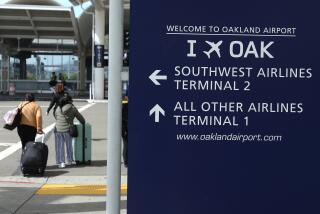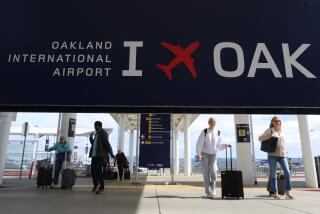Fly SUX: Sioux City embraces its snicker-inducing airport ID code
Sioux City, Iowa
THE good people of Sioux City, Iowa, just don’t get any respect.
For more than a century, the city was best known for an omnipresent smell, an unpleasant byproduct of the massive stockyards that drove the local economy. Meat packers would tell their children, “That’s the smell of money.”
David Letterman used to joke about the town, back in the days when the local CBS television station was not carrying “The Late Show.” Letterman would introduce his Top 10 list, saying it had just arrived “from the home office in Sioux City, Iowa.”
And then there was -- and still is -- the Sioux Gateway Airport’s ignominious three-letter identifying code: SUX. For decades, city fathers have moaned about the label. In 2002, the mayor labeled it “an embarrassment.”
Dave Bernstein has heard all the jokes during his 42 years in Sioux City. But, unlike some other residents, he has taken to heart the old adage about what to do when life hands you lemons. He’s making T-shirts -- emblazoned with two words: “Fly SUX.”
The Sioux Gateway Airport certainly isn’t the only airport in the world with a giggle-prompting code. There’s Fresno’s: FAT. The airport code in Perm, Russia, is PEE. And then there’s Japan’s third-busiest airport, in the city of Fukuoka. Many a traveler must snicker as his or her luggage is tagged for. . . . (We’ll leave it at Fukuoka.)
Cracking the codes
Two-letter airport codes -- such as LA for Los Angeles and PH for Phoenix -- were the norm until the increasing number of airports and landing strips necessitated three-letter codes in the 1930s. For many existing airports, an “X” was simply added, creating, for example, LAX and PHX.
Other codes are more obscure. Chicago’s O’Hare Airport got ORD because it sits on the site of a former farming community known as Orchard Place.
New Orleans’ airport is located, coincidentally, on the land on which pioneer aviator John Moisant died in a plane crash in 1910. When the property -- then a plantation -- was sold to a livestock dealer, it was renamed in honor of the pilot: Moisant Stock Yards; hence the code MSY.
And St. Petersburg-Clearwater (Fla.) International Airport isn’t famous for its lemon meringue pies, even though its code is PIE. It’s on the site of the former Pinellas Army Airfield.
As in Sioux City, the folks in St. Pete have embraced their code; the airport’s website is www.fly2pie.com.
After more than 50 years being the butt of jokes, Sioux City officials in 1988 appealed to the Federal Aviation Administration to change the airport’s moniker. The FAA offered them GAY, as in Sioux Gateway Airport. “Thanks but no thanks,” the local leaders told the bureaucrats in Washington.
Fast forward 20 years, walk into the gift shop at Sioux Gateway Airport, and witness a complete about-face: You’ll see T-shirts, baseball caps and other merchandise displaying the “Fly SUX” logo.
“It’s ‘S-U-X,’ ” says Bernstein, enunciating the letters one by one. The T-shirts were his idea.
Last fall, Bernstein -- who’s an airport board member -- had about a dozen T-shirts printed to give to travel agents at an appreciation dinner. As word of his marketing ploy spread, he was deluged with requests for the shirts.
The president of Northwest Airlines -- in Sioux City to visit his company’s new call center -- was among the first to ask for some. Since then, the line of Fly SUX merchandise has soared and now includes coffee mugs, luggage tags and bumper stickers.
“We got stuck with this SUX thing, so we’re going to embrace it, make it something that we can all laugh about,” Bernstein says.
“We have always believed, ‘Why fight it? Why not have fun with it?’ ” adds Luanne Lindblade, the owner of Sioux City Gifts, the company that markets the Fly SUX items. “Let’s exploit it rather than let it bother us.”
With Lindblade’s help, Bernstein created the logo and the T-shirts without consulting his fellow airport board members or the city council. He feared someone would say, “No.”
While he was at it, he also changed the airport’s official website to FlySUX.com, again without seeking permission. To be sure, it was unorthodox, but no one is arguing with Bernstein’s obvious success.
The number of people choosing to fly into and out of SUX is nearly double what is was one year ago. That is due, in no small part, to Frontier Airlines’ decision to add service last fall. But part of the credit may go to the “Fly SUX” campaign.
Courting fame
“It’s raised awareness as far as our airport is concerned,” says Rick McElroy, the airport manager. “People are taking a second look at Sioux City rather than taking off from the airport to the south or the airport to the north” -- references to his competitors. “I will not say their names,” he adds with a chuckle.
“I think it’s a great thing for tourism, both short- and long-term. It’s just one more interesting way to draw attention to our community,” says Erika Newton, a manager with the Sioux City Convention and Visitors Bureau and a promoter of local attractions such as the restored Orpheum Theatre and the Palmer Candy Co. museum and store, home to the Twin Bing candy bar for the last 85 years.
“It was kind of logical, in a weird, self-deprecating way,” Bernstein concludes. “It’s taken off way beyond, obviously, what anybody thought it would.”
travel@latimes.com
More to Read
Sign up for The Wild
We’ll help you find the best places to hike, bike and run, as well as the perfect silent spots for meditation and yoga.
You may occasionally receive promotional content from the Los Angeles Times.






